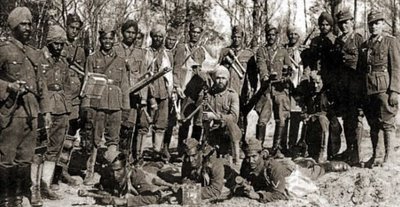An Abwehr unit [1] composed of Indian volunteers and recruits, the Indische Legion (Indian Legion) was conceived in April 1941 following the arrival in Berlin of Subhas Chandra Bose, the leader of the radical wing of the All-Indian Congress. Bose had escaped from British house arrest in Calcutta with the assistance of both the Abwehr and the NKVD (Soviet People’s Commissariat of Internal Affairs). The first members of the legion were drawn from Indian prisoners of war captured in North Africa as well as Indians living in Germany. Further efforts by Bose produced 6,000 additional volunteers, although the nucleus of the new army was limited to 300 people sent to a special training facility at Königsbrück near Dresden.
The Abwehr envisioned a campaign that would advance via the Caucasus into India and spark an anti-British revolt. In a preparatory move, Operation Bajadere was launched in January 1942, paradropping an elite force of 100 into eastern Persia (Iran) so they could commit acts of sabotage in their homeland. Yet the later German reversals at El Alamein and Stalingrad meant that the planned offensive had little chance of materializing. The main body of the Indische Legion was surreptitiously transferred to Southeast Asia and became part of the failed Japanese invasion of India through Burma. Those soldiers remaining in Europe were absorbed into the Waffen-SS in August 1944.
#
It is always necessary to distinguish between contemporary speculation and postwar sensationalism. The former process was an essential integral constituent of purposive intelligence analysis during the war, especially in the earlier phases of security-intelligence work in Persia, before a significant number of Axis or pro-Axis agents had been captured and interrogated, and the information obtained from them had been collated, cross-referenced, and corroborated. The latter phenomenon, on the other hand, is generally associated with the literature of neofascist or antifascist historical revisionism, particularly when authored by less than scholarly writers who have often employed the internet to propagate unsourced (or inadequately sourced) myths about the performance of Nazi agencies and agents in the region. An example would be the attribution to the Abwehr of a mythical parachute operation codenamed ‘BAJADERE’, together with a mythical narrative according to which 100 soldiers of the FKI entered India through Persian Baluchistan in January 1942 and carried out successful covert action on Indian soil. There is no basis for this operation in the records. Quite apart from the logistical infeasibility of such a long-range operation, the FKI was not mustered and sworn in until August 1942, only reaching its full strength of trained soldiers in mid- 1943. Equally fictional is the operation codenamed ‘AMINA’, which supposedly saw large numbers of marauding German special forces roaming around northern Persia (and even as far south as Abadan) in the aftermath of the Rashid Ali Gailani coup failure in May 1941 and before the Anglo- Soviet invasion in August 1941. Such narratives generally have in common an absurdly inflated operational scale, involving hundreds of participants. Contrast such fictions as ‘BAJADERE’ and ‘AMINA’ with the typically more modest, factual attempts by the Abwehr to insert officers singly, such as the Gräwer initiative in February 1941 or the deployment a few months later of the former First World War agent Oskar von Niedermayer to Persia (under the alias Otto Normann) in the summer of 1941, which was cut short by the Allied invasion. Niedermayer was at the time attached to Sonderstab F (Hellmuth Felmy’s special-operations staff) in Athens; he was to be sent via Turkey on a reconnaissance mission ‘of great significance for any military operations in the region, with particular reference to road conditions’.
[1] There was a factual unit named ‘Sonderkommando (SK) Bajadere’ (see Adrian O’Sullivan, Nazi Secret Warfare in Occupied Persia (Iran): The Failure of the German Intelligence Services, 1939– 45 (Basingstoke: Palgrave Macmillan, 2014), 63, 88, 164, 175, 200, 252); there is no trace or any mention of an operation by that name in the archival records. Had it existed, it would no doubt have been planned by Hans-Otto Wagner of Abwehr II, who had dealings with INA leader Bose, and it would therefore normally have been mentioned in connection with Wagner or Bose. Not surprisingly therefore, there is no mention of any such aerial deployment on Indian soil in Adrian Weale’s archives- based essay on the FKI in Renegades: Hitler’s Englishmen (London: Pimlico, 2002), 199- 201. According to Weale, the men of the FKI saw active duty only in the Netherlands (building coastal defences), France, and Germany. Apart from the odd skirmish with the French Resistance, they appear to have done no fighting at all. In fact, the Germans seem to have been anxious to keep them as far as possible from any direct confrontation with British forces.
